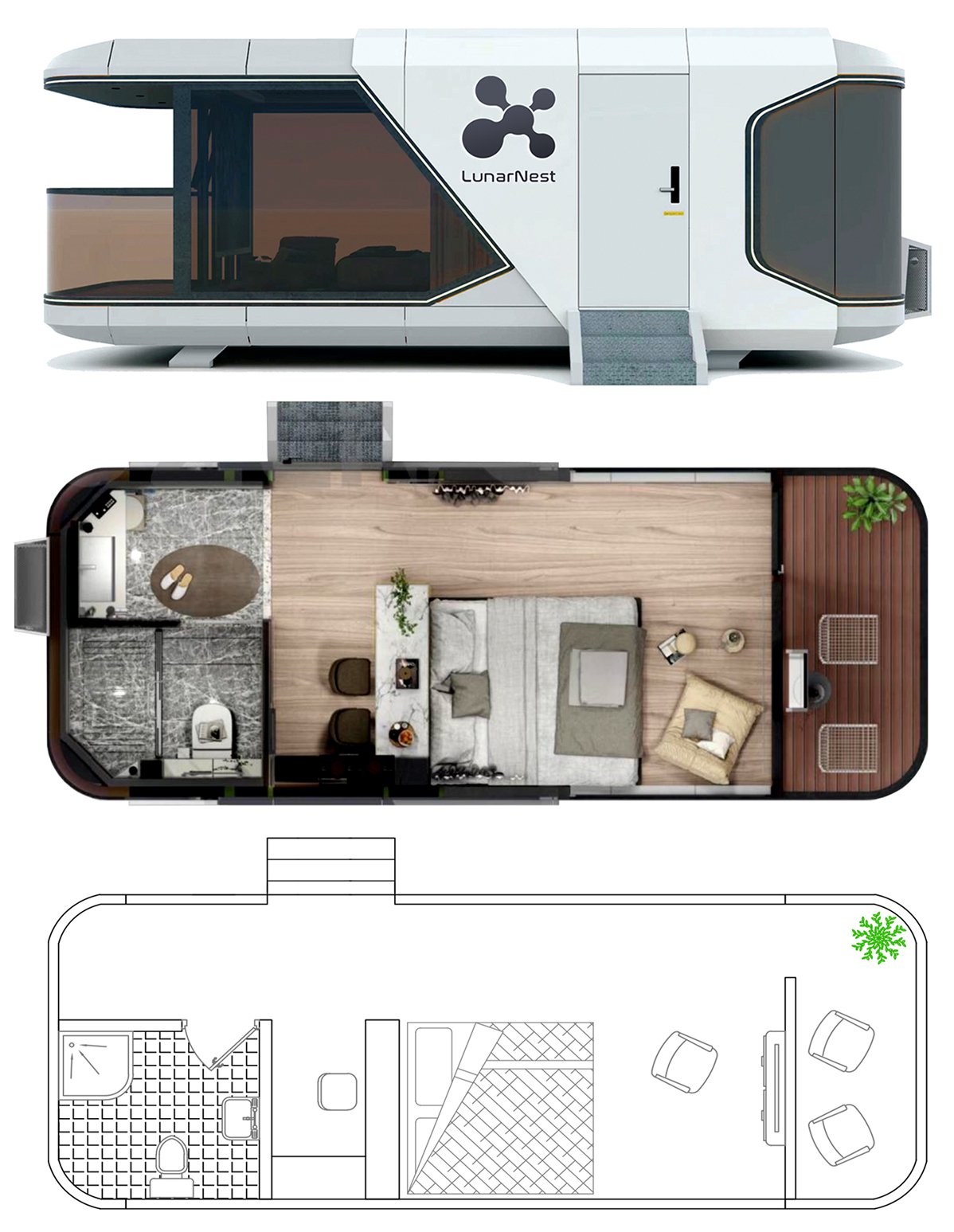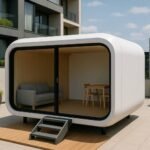The average cost of modular homes in Australia in 2025 ranges from $150,000 to $400,000, depending on design, size, and site location.
Key Takeaways:
- What factors influence modular home pricing in Australia?
- How do design choices and materials impact total cost?
- What’s the difference between modular and traditional home budgets?
- Learn how to plan, finance, and save on your modular build.
How Much Does Modular Homes in Australia Cost?
Modular homes Australia cost refers to the full expense of designing, constructing, transporting, and installing a factory-built modular dwelling. Rather than being built piece by piece on-site, these homes are manufactured in precision-controlled facilities, where every wall, module, and system is preassembled before delivery.
This process dramatically reduces build time, labour costs, and waste — while still meeting all Australian building standards (AS/NZS). Once delivered, the modules are craned into place, connected, and finished on your property within weeks.
Lunar Nest highlights that modular construction enables more predictable pricing and faster delivery compared to traditional builds. They provide clear cost guidance and outline key build stages early in the process — from design to installation — so clients have a solid understanding of costs before work begins, rather than facing the open-ended variations typical of on-site builds.
If you’re new to modular living, visit the main guide: Modular Homes in Australia: The Complete 2025 Guide
Understanding Modular Homes Australia Cost in 2025
Most projects I scope in 2025 land between $150,000 and $400,000, but your final number depends on location, design complexity, materials, inclusions, and site works. Here’s a quick benchmark by home type:
| Home Type | Size (Approx.) | Average Price Range (AUD) | Typical Use |
| Studio Pod / Granny Flat | 20–40m² | $90,000 – $150,000 | Backyard office, Airbnb rental, small accommodation |
| 1–2 Bedroom Modular Home | 60–100m² | $150,000 – $250,000 | Small family or investment property |
| 3–4 Bedroom Modular Home | 120–180m² | $250,000 – $400,000 | Full-time residence or rural home |
| Luxury Modular Home | 200m²+ | $400,000 – $600,000+ | Custom designs, premium finishes, high-end projects |
These figures represent turnkey costs, including design, fabrication, transport, and installation. Site-specific expenses — like land prep, council approvals, and connections — are separate but predictable.
Compared to traditional building, modular homes can save 15–30% in total cost while reducing build time by up to 50%.
What Affects the Cost of Modular Homes in Australia
Every build is different, but these are the big levers I help clients balance.

1. Size and Floor Plan
Size is the single biggest driver of modular homes Australia cost — both total floor area and how you use it.
- I often suggest starting small (say a 1-bed 60 m² layout) and adding modules later as family or income grows.
- Going vertical with a two-storey design squeezes more living into a compact footprint.
- Smart planning (open-plan living, integrated storage, decks, a study nook) boosts comfort without re-engineering the structure.
For inspiration, view Best Modular Home Designs for Small Australian Blocks, which showcases clever configurations for compact spaces that don’t sacrifice comfort.
2. Location and Site Conditions
Location directly affects delivery, installation, and site preparation costs. While Lunar Nest delivers across Australia, certain factors can raise or lower your overall spend:
- Distance from the factory — Transport is typically charged per kilometre; regional or remote deliveries cost more.
- Crane access and terrain — Steep, narrow, or sloping sites may require specialised cranes, adding to logistics expenses.
- Ground conditions — Poor soil quality or flood-prone areas need stronger foundations or drainage, increasing prep work.
- Local council requirements — Some councils require extra environmental or bushfire compliance certifications.
For example, installing a modular home on flat land near Sydney or Newcastle is often several thousand dollars cheaper than delivering to steep, rural terrain in coastal NSW. The good news? Lunar Nest includes site assessments early, providing a transparent, location-specific cost plan so you can make informed decisions from day one.
3. Design Complexity
Design is where personality meets practicality — and cost. The most cost-efficient forms are simple rectangles with single-skillion or flat roofs.
If you add multiple wings, big spans, high ceilings, or curved façades, expect ~10–25% more for engineering, structure, and assembly.
That doesn’t mean sacrificing style. I use a design-smart approach — floor-to-ceiling glazing where it matters, a modern cladding mix, and well-placed outdoor zones — while keeping the structural grid efficient.
4. Materials and Finishes
Material selection has a major effect on modular pricing, influencing both the upfront spend and long-term maintenance.Most modular homes in Australia are built using durable steel or engineered timber frames, finished with weather-resistant cladding suited to local conditions. The difference comes down to inclusion level — typically Standard, Premium, or Luxury.
Here’s a breakdown of what each tier may include:
- Standard Range: High-quality, cost-effective materials such as vinyl flooring, composite cladding, and energy-efficient lighting.
- Premium Range: Timber or hybrid floors, stone benchtops, designer fixtures, and upgraded insulation.
- Luxury Range: Architectural cladding (like Colorbond or timber slats), custom cabinetry, premium appliances, and high-end finishes.
I’ll often blend tiers (for example, Standard interior + Premium façade) to keep the base cost competitive while lifting street appeal.
5. Site Preparation and Services
Before your modular home arrives, your land must be ready for installation.
This includes clearing, grading, and preparing services like electricity, water, and sewage connections.
Depending on your land’s condition, these costs typically range from $10,000 to $50,000.
Common cost drivers include:
- Slope — Steeper blocks may require retaining walls or elevated footings.
- Soil type — Sandy or reactive clay soils might need additional compaction or piering.
- Access routes — Tight driveways or rural tracks may need temporary widening for trucks or cranes.
6. Sustainability and Off-Grid Features
Many homeowners choose off-grid modular homes because of their environmental performance and energy savings. Integrating sustainable features can slightly raise upfront costs but delivers long-term value through reduced energy bills and better comfort.
Popular eco-upgrades include:
- Solar systems and battery storage for energy independence.
- Rainwater tanks and greywater recycling for water efficiency.
- High R-value insulation and double glazing for thermal performance.
- Passive design principles — orienting your home for natural light and airflow.
While each feature can add $10,000–$40,000 to your budget, many clients recover this investment within 5–10 years. You can explore detailed options and examples in sustainable & off-grid living.
7. Customisation and Smart Upgrades
Modular homes are built for flexibility — which means you can easily customise your floor plan or add smart features.Each adjustment adds a marginal cost but increases functionality and long-term property value.
Examples include:
- Adding a home office pod for remote work or a guest suite for Airbnb income.
- Integrating smart home systems such as automated lighting, heating, and energy monitoring.
- Planning for future expansion by designing your modules so you can add new sections later without disruption.
Lunar Nest specialises in “future-proof” modular architecture — homes that adapt as your lifestyle changes. These upgrades may lift total project costs slightly but offer unbeatable flexibility over time.
How Modular Homes Compare to Traditional Homes (Cost & Time)
| Feature | Modular Homes | Traditional Homes |
| Build Time | 12–20 weeks | 12–18 months |
| Cost per m² | $1,800 – $2,500 | $2,500 – $3,500+ |
| Construction Process | Off-site fabrication, on-site installation | Entirely on-site |
| Weather Delays | Minimal | Common and costly |
| Environmental Impact | Low (less waste) | High (more waste) |
| Design Flexibility | High (modular customization) | High, but slower |
| Pricing Model | Fixed, transparent | Often variable, risk of overruns |
In short: modular homes deliver greater efficiency, cost predictability, and sustainability.
That’s why homeowners and developers across Australia are shifting toward modular construction for 2025 and beyond.
If you’d like a side-by-side comparison of prefab styles, explore Modular Homes vs Prefab Homes: What’s the Difference?.
Hidden Costs to Watch For (and How to Avoid Them)
Modular is great value, but I always budget for these:
- Council fees and approvals – Costs vary by state but typically range from $3,000–$8,000.
- Site access upgrades – Narrow roads or crane restrictions may require traffic management.
- Utilities connection – Electrical, sewer, and NBN hookups are site-specific.
- Interior design choices – Upgrading kitchens, bathrooms, or finishes can raise total spend.
- Landscaping or decking – Usually quoted separately but enhances overall value.
With Lunar Nest’s transparent quoting process, these extras are identified upfront, helping you plan confidently.
Financing Your Modular Home
Financing modular homes in Australia has become easier. Major banks and lenders now recognise modular builds as permanent dwellings, making them eligible for standard home loans and construction financing.
Lunar Nest doesn’t offer in-house finance, but they can provide documentation and guidance to support you if you’re working with an external finance provider, mortgage broker, or grant application throughout your modular build process.
If you’re exploring finance options, read: Modular Home Financing Options for Australians
Cost-Saving Tips for Building Modular Homes in 2025

If you’re planning a modular build in 2025, you can reduce expenses without sacrificing quality:
- Choose a pre-designed layout — it’s more affordable than a custom plan.
- Simplify rooflines and structure to cut material and crane costs.
- Opt for energy-efficient upgrades early (they save money long-term).
- Build in stages — start small and expand later with additional modules.
- Work with a local modular specialist like Lunar Nest to minimise delivery and approval fees.
Smart planning early on ensures you get the best value from your investment.
Plan Your Modular Home Budget with Lunar Nest
Whether you’re dreaming of a compact studio or a luxury family retreat, Lunar Nest can help you plan your project with clarity, transparency, and expert guidance.
Explore your next step:
- Download our Catalogue — browse modular layouts and pricing guides.
- Contact Lunar Nest — get a tailored quote for your site.
Frequently Add Questions
How much does a modular home cost in Australia in 2025?
Between $150,000 and $400,000, depending on size, location, and finishes. Larger or custom designs may exceed $600,000.
Are modular homes cheaper than traditional builds?
Yes — modular construction can save 15–30% on average due to efficient manufacturing and reduced on-site labour.
Can modular homes be financed with a standard home loan?
Yes. Most lenders now offer standard mortgages for modular homes built to Australian codes.
What’s included in a modular home quote?
Generally includes design, factory construction, transport, and assembly. Site prep, approvals, and optional extras are quoted separately.
Are modular homes good long-term investments?
Absolutely. They’re durable, energy-efficient, and built to last — holding similar resale value to traditional houses.





